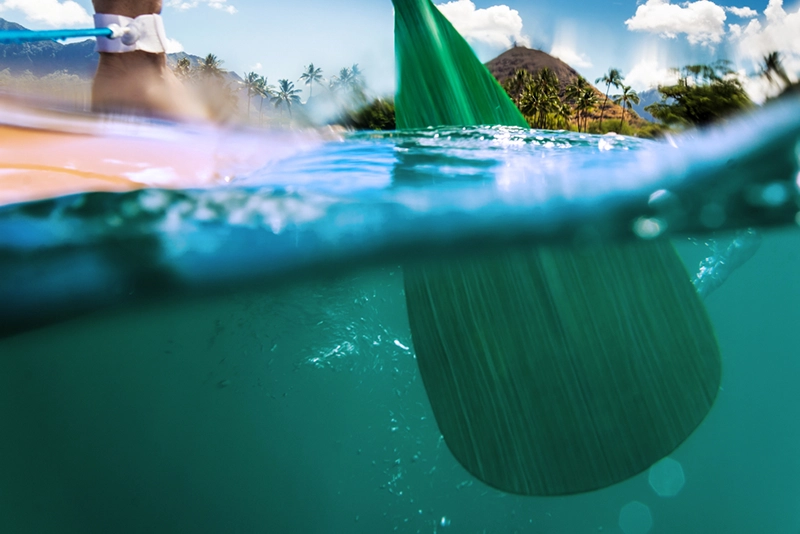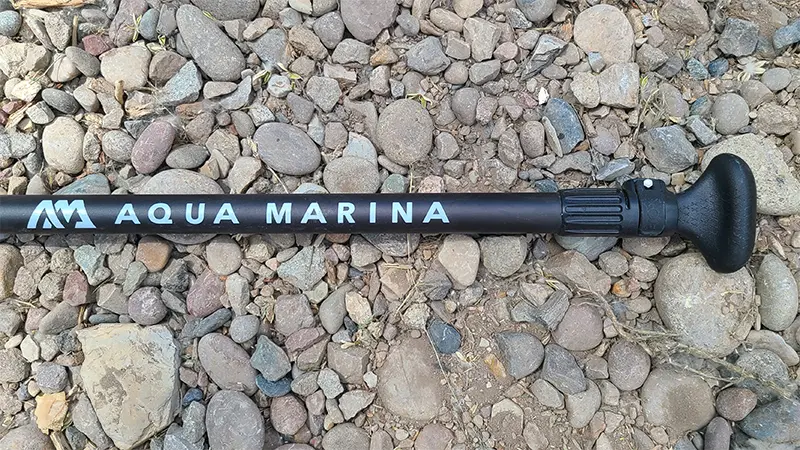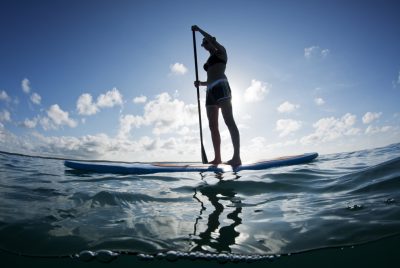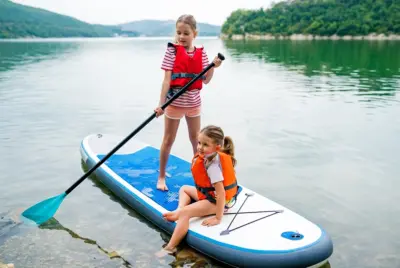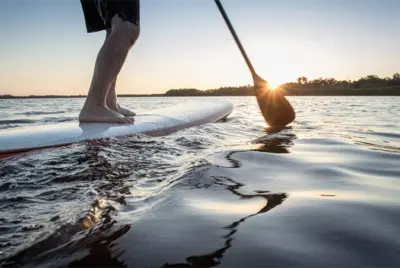Paddle Board Paddles: Unraveling the Magic
We may earn a commission for purchases made using our links. Please see our disclosure to learn more.
Paddle board paddles are more than just a means to push yourself across the water’s surface. They’re a critical part of your stand-up paddle boarding (SUP) equipment, significantly influencing your performance and enjoyment on the water. So, grab a cup of joe and let’s dive into the marvelous world of paddle board paddles!
Paddle Board Paddles: A Closer Look
The Anatomy of Paddle Board Paddles
Just like a well-tuned orchestra, every part of the paddle plays a crucial role. Paddle board paddles typically consist of three main parts: the blade, shaft, and handle. The blade’s shape and size, the shaft’s length and material, and the handle’s design all come into play when paddling.
Materials Matter: Choosing Paddle Board Paddles
Selecting the right material for your paddle board paddle is a vital aspect of your overall paddle boarding experience. The material affects factors such as weight, durability, performance, and price of the paddle. This section will explore the most common materials used for paddle board paddles, their pros and cons, and how to choose the best one for your needs.
ALUMINUM PADDLES
Aluminum paddles are an excellent choice for beginners due to their affordability and durability.| Pros: | Cons: |
|---|---|
| Cost-effective: Ideal for those on a budget or just getting started in paddle boarding. | Weight: Aluminum paddles are typically heavier than those made from other materials, which can lead to quicker fatigue. |
| Durable: Can withstand heavy use and rough conditions. | Cold touch: In colder weather, aluminum can feel quite cold to the touch. |
PLASTIC PADDLES
Another budget-friendly option, plastic paddles, are typically combined with an aluminum shaft.| Pros: | Cons: |
|---|---|
| Affordability: Similar to aluminum paddles, plastic paddles are economical and suitable for beginners. | Weight: Plastic paddles are relatively heavy, potentially leading to quicker fatigue. |
| Durability: Plastic blades can withstand impact well, making them suitable for rocky or shallow waters. | Performance: Plastic blades lack the stiffness of other materials, resulting in less efficient power transfer during each stroke. |
FIBERGLASS PADDLES
Moving up the scale in terms of price and performance, fiberglass paddles offer a balance between weight, durability, and cost.| Pros: | Cons: |
|---|---|
| Lightweight: Fiberglass paddles are lighter than aluminum or plastic, reducing arm fatigue. | Cost: Fiberglass paddles are more expensive than aluminum or plastic alternatives. |
| Durability: They offer a good balance between weight and strength, making them durable yet light. | Fragility: They may not withstand rough handling as well as plastic or aluminum paddles. |
CARBON FIBER PADDLES
At the top end of the scale, carbon fiber paddles are favored by experienced and professional paddle boarders.| Pros: | Cons: |
|---|---|
| Performance: Carbon fiber offers superior stiffness, providing efficient power transfer and making each stroke count. | Cost: Carbon fiber paddles are the most expensive on the market. |
| Lightweight: Carbon fiber paddles are the lightest on the market, reducing fatigue and enabling longer paddling sessions. | Delicate: While strong and stiff, they may not tolerate impact or rough handling as well as other materials. |
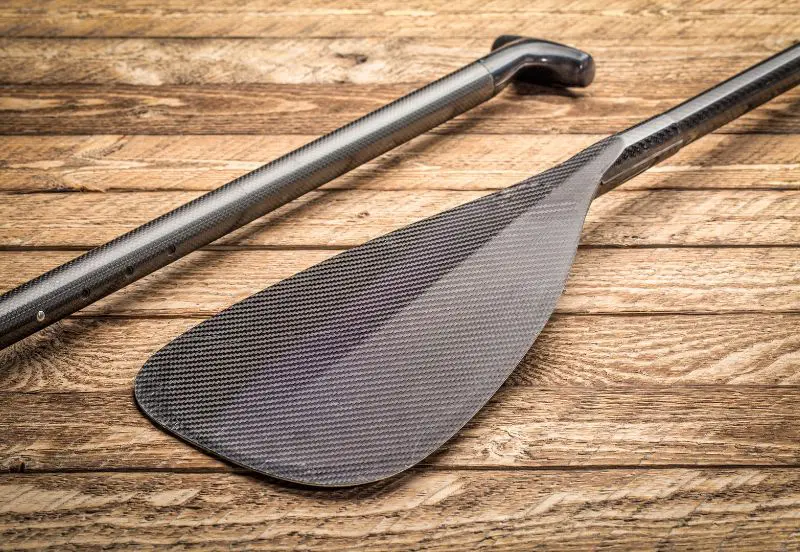
Remember, the best material for your paddle board paddle largely depends on your personal needs, experience level, and budget. Carefully consider the pros and cons of each material before making your decision. Ultimately, the right paddle can make your time on the water more enjoyable and efficient.
The Importance of Blade Design in Paddle Board Paddles
Shapes and Sizes: A Balancing Act
The blade’s shape and size directly affect your paddling efficiency. Larger blades provide more power, while smaller ones offer less resistance. Whether you’re a slow cruiser or a speed demon, there’s a blade size and shape that’s just your cup of tea!
The Impact of Blade Angle
The blade’s angle, or “dihedral,” plays a pivotal role in guiding the water flow across the blade, ensuring stability during each stroke. It’s not rocket science, but here’s some fluid dynamics involved.
How to Choose the Right Paddle Length
Selecting an appropriate paddle length is a significant factor in ensuring an effective and comfortable paddle boarding experience. The correct length improves the efficiency of your strokes, supports good posture, and minimizes discomfort. Let’s delve into the aspects you need to consider.
Your Height: The First Building Block
One of the cardinal rules of choosing the right paddle length is to take into account your height. A common rule of thumb is to pick a paddle that’s roughly 6 to 12 inches taller than you. This height allows for a comfortable reach without straining your back or arms. But remember, this isn’t a one-size-fits-all solution. You’ll need to consider other factors as well.
Your Board’s Thickness: The Second Piece of the Puzzle
Your paddle board’s thickness is another crucial factor. The thicker your board, the higher you stand off the water. Hence, if you’ve got a thick board, you’ll likely need a longer paddle to comfortably reach the water. On the flip side, a thinner board might require a shorter paddle.
Your Paddling Style: The Icing on the Cake
The way you paddle also affects the optimal length of your paddle. If you enjoy a leisurely paddling style with longer, slower strokes, a longer paddle may be more suitable. On the other hand, if you prefer a more vigorous, fast-paced paddling style, a shorter paddle would be more beneficial. A shorter paddle allows for quicker strokes, enabling you to move through the water at a faster pace.
Adjustable Paddles: The Best of Both Worlds?
If you find it challenging to find a balance between these factors, an adjustable paddle might be a beneficial choice. These paddles provide the flexibility to adapt to various paddlers, boards, and paddling styles. They offer the ability to alter the length to accommodate different conditions, whether you’re on flat water, riding waves, or if the paddle is being used by different people.
Ultimately, the choice of paddle length should prioritize comfort. The goal is to paddle effortlessly and enjoy your time on the water without any undue discomfort or strain. It may require some experimentation to find the perfect fit, but this process is key to enhancing your paddleboarding experience.
The Role of the Shaft in Paddle Board Paddles
The Influence of Shaft Flexibility
The flexibility of the shaft in paddle board paddles is an aspect that can greatly affect your paddling experience. Shaft flexibility refers to the ability of the shaft to bend or flex during the paddling motion. Let’s dive into how shaft flexibility can influence your performance, comfort, and the suitable options for different paddling styles.
The Impact on Performance
The flexibility of the shaft can impact the power and control you have over your paddleboard.
Stiffer Shafts: A stiffer shaft generally allows for more powerful strokes. This is because less energy is lost in the flexing of the shaft, and more is transferred directly to the water. This makes stiffer shafts suitable for racing or situations where speed is essential.
Flexible Shafts: On the other hand, a more flexible shaft can be more forgiving and easier on the joints. However, they generally provide less power per stroke compared to stiffer shafts. Flexible shafts are suitable for long, leisurely paddling sessions.
The Impact on Comfort
Shaft flexibility also plays a significant role in the comfort levels experienced during paddle boarding.
Stiffer Shafts: While they allow for powerful strokes, they can also put more strain on your joints, especially if you are paddling for extended periods.
Flexible Shafts: They can be more comfortable for long sessions as they absorb some of the forces exerted during paddling, reducing the strain on your joints and muscles.
Choosing the Right Shaft Flexibility
When choosing the flexibility of your paddle’s shaft, consider your paddling style and physical attributes.
For Speed and Racing: If you are into racing or love the thrill of speed, a stiffer shaft may be more suitable.
For Casual Paddling: If you are more into casual paddling and prioritize comfort, a more flexible shaft could be the better option.
Physical Considerations: Also, consider your physical strength and any joint issues. Those with joint issues or lower strength may find a more flexible shaft to be beneficial.
In conclusion, shaft flexibility is an essential factor in paddle board paddles that influences both performance and comfort. It’s important to consider your paddling style, physical attributes, and personal preferences when choosing the flexibility of your paddle’s shaft.
Adjustability and its Perks
The joy of sharing is second to none! Adjustable shafts allow multiple paddlers to use the same paddle, making them a popular choice for families and rental businesses.
“With my paddle board paddle in hand,
I glide o’er the waves feeling grand,
on a beautiful watery wonderland!”
Grip Comfort: The Unsung Hero of Paddle Board Paddles
When it comes to paddle boarding, grip comfort is often an overlooked aspect, yet it is crucial for an enjoyable and efficient experience. The grip is where your hands interact with the paddle, and ensuring comfort can make a world of difference in both your performance and enjoyment. This section will dive deeper into the importance of grip comfort, the different types of grips, and how material plays a role.
The Significance of Grip Comfort
Having a comfortable grip is paramount because it affects how well you can control your paddle and, in turn, your movement through the water. A comfortable grip reduces the risk of blisters and fatigue, allowing you to paddle for extended periods without discomfort.
Furthermore, a good grip can improve the efficiency of your strokes. It enables you to maintain a firm yet relaxed hold, ensuring that energy is not wasted through a grip that’s too tight or too loose.
Types of Grips
T-Handle Grip: The T-handle grip is common and is shaped like the letter ‘T’.
Ergonomic Grip: Ergonomic grips are shaped to fit the natural contours of your hand.
Palm Grip: Palm grips are rounded and designed to fit comfortably in the palm of your hand.
| T-Handle Grip | Ergonomic Grip | Palm Grip | |
|---|---|---|---|
| Pros: | Provides a secure grip, making it easier to control the paddle. It is ideal for strong, powerful strokes as it allows for a firmer hold. | Provides increased comfort, especially during extended paddling sessions. Reduces the strain on the wrists and forearms. | Comfortable for a wide range of hand sizes. Encourages a relaxed grip, reducing hand and forearm fatigue. |
| Cons: | Some people find the T-shape uncomfortable over long durations. | Can be more expensive compared to standard T-handle grips. | May not provide as much control for powerful strokes compared to T-handle grips. |
Materials and Grip Comfort
The material of the grip also plays a significant role in comfort. Common materials include:
Rubber: It’s comfortable and provides excellent grip even when wet, but can wear out faster than other materials.
Plastic: It’s durable but may not provide the same level of comfort as other materials.
Foam: It’s extremely comfortable and lightweight, but not as durable as plastic or rubber.
Carbon: It’s lightweight and stiff, offering performance benefits, but may not be as comfortable as foam or rubber.
Grip comfort is an essential but often overlooked aspect of choosing paddle board paddles. The type and material of the grip can significantly affect both comfort and performance. When selecting a paddle, it is important to consider the type of grip and material that best suits your hands and paddling style. Taking the time to choose the right grip can lead to a more enjoyable and efficient paddling experience.
Conclusion
All things considered, paddle board paddles are more than just an accessory; they’re your loyal comrades on your SUP adventures. Whether you’re just getting your feet wet or already riding the waves like a pro, understanding these paddles can help you elevate your paddle boarding experience. After all, it’s the little things that make a big splash!
FAQs about Paddle Board Paddles
1: How often should I replace my paddle board paddles?
Well, that depends on how often you use them and how well you take care of them. On average, a well-maintained paddle can last anywhere from 1 to 5 years.
2: How can I clean my paddle board paddles?
Cleaning your paddle is a piece of cake! Just rinse it with fresh water after each use and let it dry naturally.
3: How much do paddle board paddles cost?
The price can range from around $50 for basic models to over $300 for high-end carbon fiber paddles. It all depends on your budget and needs.
4: Are lighter paddles always better?
Not necessarily. While lighter paddles reduce arm fatigue, they’re often more expensive and less durable than their heavier counterparts.
5: Can children use adult-sized paddle board paddles?
For the kiddos, it’s best to opt for adjustable or youth-sized paddles. Adult-sized paddles might be too large and heavy for them to handle.

